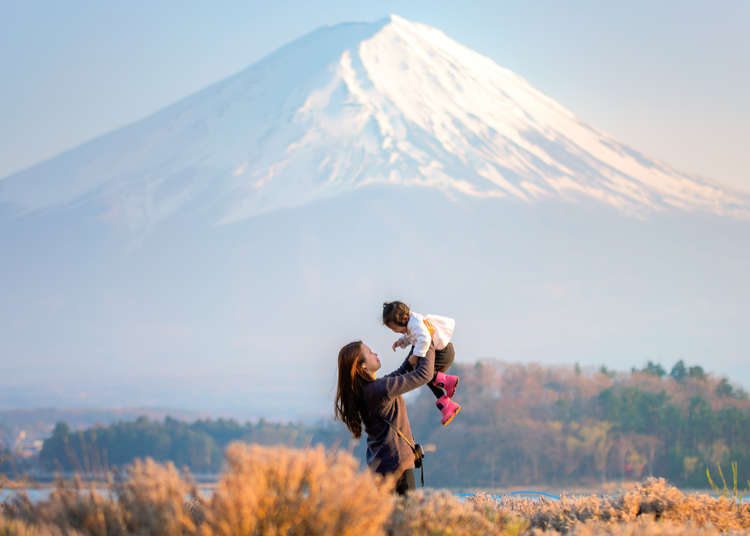
Holidays with kids to any country can be challenging, and even more so when it is a long distance trip to a very different culture, but luckily we are here to set the record straight on what you need to know about visiting the mystical land of the rising sun, but with children! Here we’ll cover everything you need to know: from getting to Tokyo from the airports, to tips on kid-friendly accommodation, food, and more. Let’s dive right in.
1. Starting, and ending, your journey: At the airport
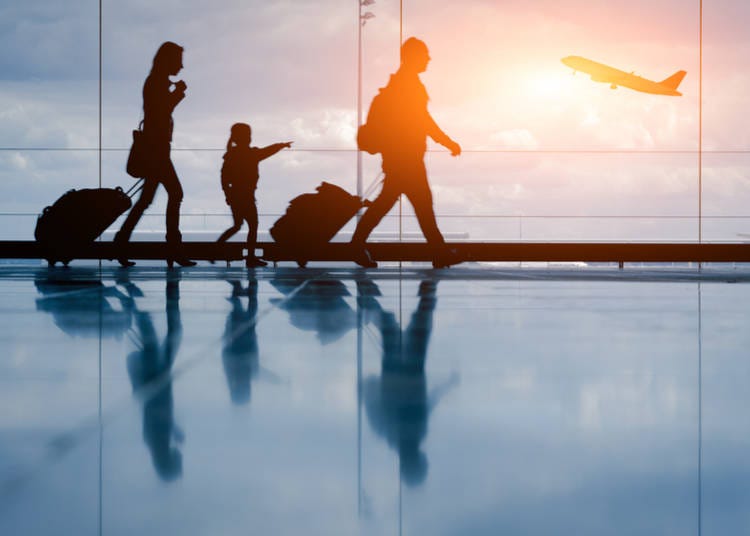
Every journey to Japan will start, and end, with an airport and for young kids your first consideration will be your pram or stroller. It is best to ask your airline to deliver this to you upon arrival at the airplane door, though if you have opted for it to be with your luggage then at an airport like Narita you can get a rental stroller to use until you are reunited with your own one. (Vice versa when departing Japan you will have the option of using your stroller right up to the gate, or checking in your stroller and using a rental one.) This rental stroller is free of charge.
The next important consideration, especially when arriving, and your child is in desperate need of a change or feed, is the child facilities in the airport. At Tokyo’s airports you will be delighted to find spacious and modern baby facilities where there are private booths for nursing or feeds, baby chairs, hot water machines and comfortable diaper changing tables. There are a lot of them, and they are pretty much perfect!
2. Getting to Tokyo with kids: from Narita Airport
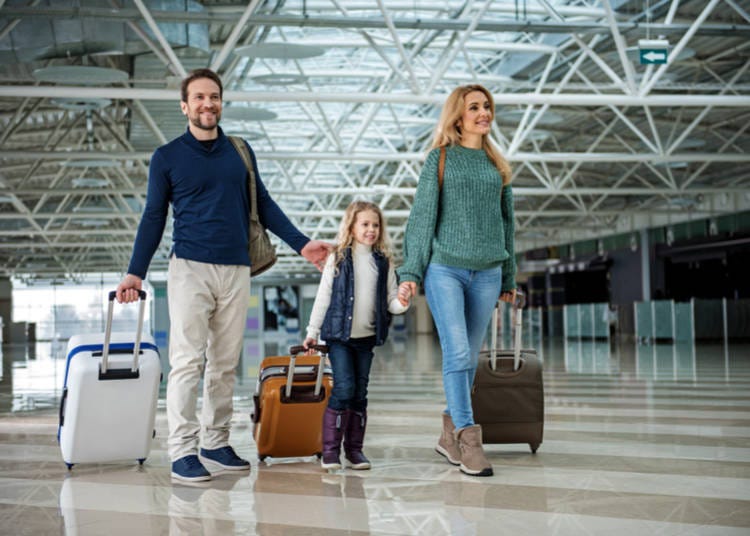
Option 1: Taxi
From both Tokyo airports to central Tokyo most people opt for the train, and for groups travelling with kids this is probably the most convenient – unless your budget includes travel by taxi. Narita Airport is around 68km (42 miles) away from Tokyo, so a taxi can cost upwards of 20,000 yen (~$200) from Narita. However there are shared mini-bus services which can be booked and which may be cheaper than a taxi. For example, Green Tomato offers a shared mini-bus from the airport to your hotel from 5,200 yen per person.
Option 2: Bus
A coach is much cheaper than taxi. For example from Narita airport to Tokyo station can cost 1,900 yen (per person – adult fare) for a round trip ticket with Tokyo Shuttle, but when travelling with toddlers or very small children there is very little space – especially when the coach is fully booked and crowded.
Option 3: Standard train (unreserved seat)
Trains tend to be mid-budget in terms of cost, but are still quite reasonable. Two train companies connect Narita Airport to Tokyo: Japan Rail (JR) and Keisei Railway. These offer two general kinds of tickets: one for standard trains and one for faster express trains.
Taking the JR line from Narita Airport to Tokyo Station (via the Sobu Line - Rapid) is a ride of around 90 minutes and will cost ¥1,320 one way. Taking the Keisei Line will take just over an hour and costs around ¥1,030 one way. Note that the Keisei Line will only go as far as Ueno, on Tokyo’s east side; depending on your accommodations you may need to transfer.
Provided you don’t travel during the morning rush hour, there is a nice amount of space and for both trains your kids will be entertained by the view outside. On the Keisei Line normally the first and last carriages have a dedicated stroller space. However, for both the Keisei line and the JR Sobu line, besides the possibility of overcrowding during certain times of the day, there are no toilets and little storage space.
Option 4: Express train (reserved seat)
If you’re looking to get into Tokyo quickly (which can help keep the kids happy, too), you’re in luck: for a little extra money you can get a reserved seat on either the JR Narita Express (N’EX). It costs3,020 one way, with a discounted ticket price of ¥1510 for children under eleven or free for kids under six and it takes 53 minutes to Tokyo Station.
Alternatively, the Keisei’s Skyliner can get you to Ueno Station in 41 minutes for ¥2,200 one way if you book through Keisei’s website. In addition it costs ¥1,100 for children under eleven and is free for kids under six. Besides being fast, these kinds of trains have more space, as well as multi-purpose rooms and toilets with baby changing tables – it is important to keep in mind that not all coaches may have toilets in comparison!
Getting to Tokyo with kids: from Haneda Airport
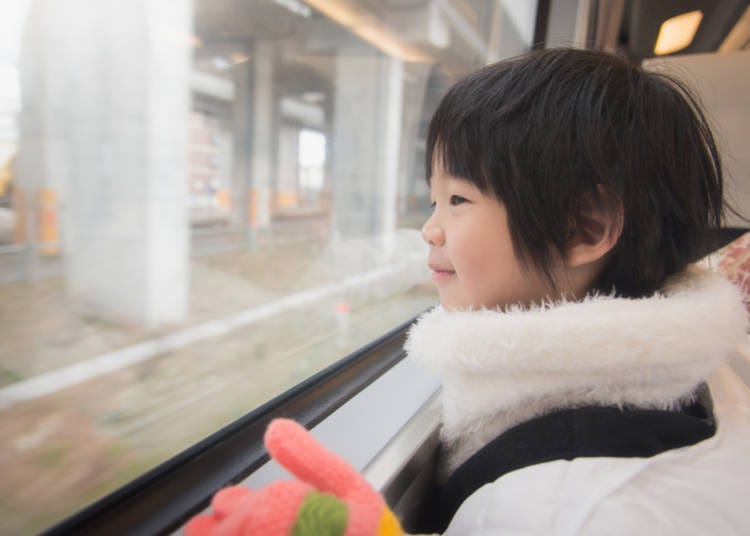
Option 1: Taxi
As Haneda airport is closer to Tokyo taking a taxi is a slightly more reasonable method of transportation, especially as taxis from this airport offer a flat-rate fare. For example, the cost of travelling from the airport to the Chiyoda area is ¥5,900, which travelling to the Shibuya area costs ¥6,600. Please note that there is an extra charge for late at night or early in the morning which ranges from ¥1,200 to the Chiyoda area to ¥2,000 extra for a destination in Musashino.
There are two types of taxis available, sedans and wagon type cars, depending on the size of your family and how much luggage you have, the sedan is quite spacious but the wagon type offers the most room. However, there are fewer wagon type cars so you may have to wait. For a family of four, for example, travelling by taxi to somewhere in Chiyoda is quite inexpensive, and the journey to somewhere like Tokyo Station can be made in 25-30 minutes. Taxis can be found on the first floor of Haneda Airport International Terminal.
Option 2: Bus
Taking a coach offers a cheaper alternative but takes longer, around 40 minutes, to Tokyo Station. The benefit for taking a coach is the price, ¥930 one way for an adult, ¥470 one way for a child aged 6 to 11 and free for children under 6, and the rather spacious storage space. There is no toilet, and there is the risk of being in a full coach and stuck in traffic, so plan accordingly!
However, for a large family, or one with a lot of luggage plus a stroller, a coach does offer certain benefits and at certain times, i.e. not during rush hour, can be fairly quick. Bus tickets can be bought at the bus counters in the arrival lobby on the second floor and at vending machines by the bus stops outside the first floor of Haneda Airport International Terminal.
Option 3: Train (unreserved seat)
a. Tokyo Monorail
From the arrival lobby of the second floor it is just a short walk to the entrance gates for the Keikyu Line and the Monorail. The Monorail is an exciting choice for kids as it glides over waterways and buildings, making it a real visual treat! However, while it has plenty of storage areas for luggage it is not exactly stroller friendly as the storage spaces are raised above ground level and there is otherwise not much convenient space for strollers without being in other people’s way.
On the plus side the Monorail only lasts 13 minutes to its final stop of Hamamatsucho Station and only costs ¥490 one way for an adult and ¥250 one way for a child aged 6 to 11 (it is free for children under 6). Although this is quick and cheap, chances are you will then need to transfer onto the Yamanote Line so it is best to keep in mind that the elevators at Hamamatsucho Station (Monorail) are rather small if you have a stroller and luggage, and this station can be quite busy.
b. Keikyu Line
The Keikyu Line offers some advantages over the Monorail depending on your destination, but it is best to keep in mind that only normal trains run on the Keikyu Line with no dedicated luggage storage or toilets. However, you can find dedicated stroller space in the first and last carriages where you can also put luggage if the space isn’t being used. It costs ¥410 one way for an adult to Shinagawa Station, and the journey takes 11 minutes, for a child aged 6 to 11 it costs ¥205 and it is free for children under 6.
Transferring at Shinagawa is rather painless, although it is a busy station it is also very large and it offers the ability to transfer onto both JR lines and the Shinkansen. The Airport Express train offers the option to get onto the Asakusa Line without changing train, this is one of the peculiarities of Japanese trains that the Airport Express train after Shinagawa Station suddenly becomes an Asakusa Line train. A final point is that if you are travelling into Shinagawa, or further along from there, that it can be extremely busy during rush hour.
Pro tip: Use the luggage delivery service at the airport!
If you are planning a long stay in Tokyo, and aren’t in immediate need of your luggage, you can arrange at the airport for your suitcases to be delivered straight to your hotel. This is really handy when you have kids and you are travelling via a train or coach and want to be hands-free apart from a stroller.
At Narita Airport you can find dedicate luggage delivery companies on the international departure floors in both terminals like Yamato, JAL ABC and KTC and they are open from early in the morning until the very last flight of the evening. At Haneda Airport you can find luggage delivery companies Sky Building Service and JAL ABC on both the second and third floors.
You can find out further information about this service at the airport or by using the following link:
3. Where to stay in Japan with kids

Accommodation, and the options available to you, will vary depending on your budget. Something like a hostel isn’t really a good idea if you have very young kids or babies, while a five star hotel will normally have a crib available for use.
Cheaper hotels, particularly ‘business’ hotels, will likely not have any baby friendly options, but most 3 star and above hotels will have bed-guards so that your child can sleep with you or on a separate bed. Before you book your hotel it is best to check directly with them what options they have if it isn’t clear on the website you are using to book rooms.
Another option is go fully Japanese on sleeping arrangements! Parents in Japan usually sleep in the same bed as their child, on a futon. Travelling with children is a perfect excuse to stay at a traditional ryokan (Japanese inn) and try sleeping on a futon in a tatami room. In particular, having another futon is cheaper than booking a hotel room with extra beds and as the futons are on a tatami floor you don’t have to worry about your child falling out of the bed or rolling around.
Regardless of the type of hotel or ryokan you book the receptionists will normally be more than helpful in offering recommendations, arranging your luggage to be sent to your next destination, booking taxis, etc., in order to make your stay more comfortable.
4. Where to eat in Japan with kids
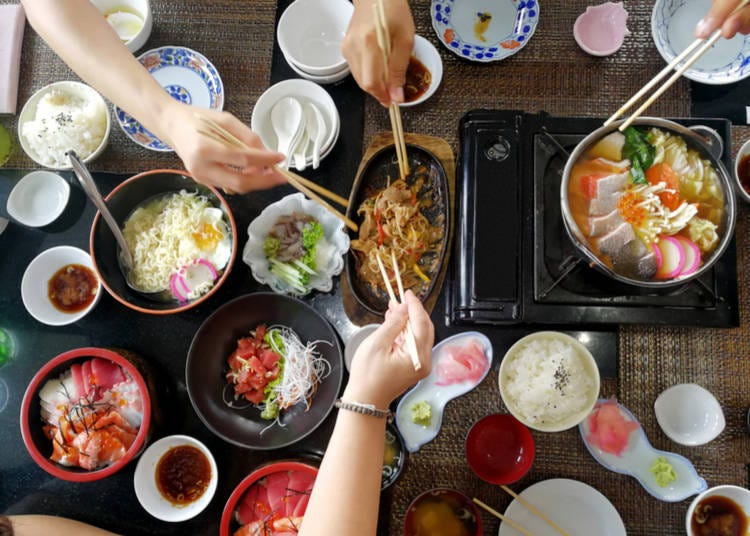
The subject of children and eating can be a difficult one, even without travelling to another country, as sometimes they just won’t like even foods they normally like! However, Japan has an amazing array of both traditional Japanese food and variations of western food to suit every taste.
For nursing while out and about it is always best to head to the nearest department store, department stores always have at the very least a dedicated baby changing room with a private area for nursing, and for bigger department stores you will find an amazingly big room with private nursing booths, dedicated baby changing tables, hot water machines and general seating.
When eating with toddlers, family restaurants will always have baby chairs and children’s menus, though if you are carrying your own food for your toddler it is no problem to feed them this in a restaurant. For older kids you will have more options as the full range of cafes and restaurants are open to you. For toddlers and small children it is worth investigating if there are any children’s cafes in the local area. These normally charge a small fee per hour but have dedicated play areas and many toys, and in most cases serve up food for both adults and children.
A family that recently visited had this to say: “Everywhere you go there is at least written Information in English, and as everything works like it should you don't need anybody to solve problems. With the food it really helped that you can often see how the food looks like before you enter a restaurant. Our kids especially liked fish together with rice and they didn't get tired of it.”
5. Travelling on Trains in Tokyo with kids

A big consideration for travelling within Tokyo is whether you have a stroller or not. If they fold up then you can get them into the boot of a taxi; city buses in general are quite small and are not a good choice for a family with a stroller (regardless of whether it folds up or not), while on the metro you can usually rely on the first and last carriages having dedicated stroller space.
A taxi is a good option, and is fairly reasonably priced, for short distances, and you can also find sightseeing taxi services which are really convenient if they fit into your budget. In general though if you need to take a bus to your destination, and it isn’t far, it is better to take a taxi.
Fortunately, Tokyo is well served by its network of metro services so within central Tokyo you can normally get where you want to go by train. Train stations pretty much without exception have elevators so you never have to worry about carrying your bags and stroller (plus children) up and down stairs or escalators, and are very accessible. Babies and young children aged up to six can ride for free and tickets for older children, aged six (a six year old not attending elementary school can ride for free) to eleven are half price.
While toilets can be found in every station, the quality can vary quite a lot and smaller stations are unlikely to have baby changing facilities. An important point to keep in mind is that sometimes there is a baby changing table in the toilets, but in the women’s toilets only. If you are a father travelling alone with a baby you may want to head to a baby changing facility at your nearest department store or shopping mall.
A family that visited Tokyo not too long ago had these tips: “There are always metro maps in English close to the Japanese ones so it is easy to understand. There is huge respect for families with children – we never had to ask for a seat, if you are around with a small kid, people offer you a seat immediately. The markings at the metro stations, which show where the door is, and where there are special seats, make you feel prepared before the train even arrives. We never had any hectic running around to carriage door or to the carriage with special seats.”
6. Travelling within Japan with kids
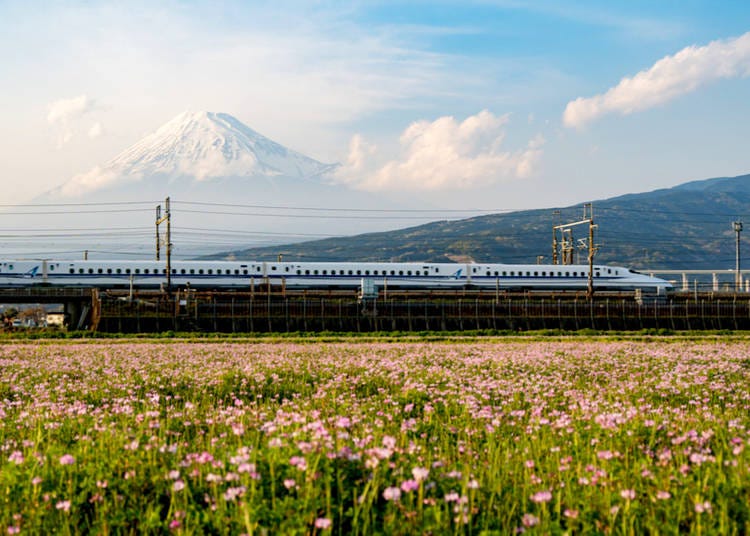
For longer journeys the shinkansen and airports will be your friends, really they will be your friends! It will depend on your budget and whether you are using the JR Rail Pass or special reduced price airline tourist tickets, but in either case they are very convenient for families.
However, while for a short journey like Tokyo to Nagoya the shinkansen is definitely quicker (about two hours), for longer journeys like Tokyo to Fukuoka (5-6 hours by shinkansen) travelling by plane does offer its advantages. This is due to the bane of every family’s existence when using the shinkansen – the lack of dedicated stroller/luggage space. It is unfortunate, but while shinkansen station access, facilities and access to the platform, are all very good, and the shinkansen itself offers a nice, comfortable and quick ride, in every carriage there is only a small little storage space located behind the very last row. If that space is taken then you have no choice but to squeeze it between your legs and the seat in front of you. If you do travel by shinkansen, and you have both luggage and a stroller, then it is best to send these directly from your hotel to your next hotel and use a baby carrier (along with a bag of essential things) on the shinkansen – this will cause you the least amount of stress and allow you to enjoy the journey!
In contrast, travelling by plane means that you can enjoy airport facilities and shopping, don’t have to worry about finding storage space for your luggage or stroller and you can enjoy a more hands-free experience. While being in the air with a baby or small child can be difficult, depending on the child, a journey like Tokyo to Fukuoka can be completed in less than two hours which is far better than managing a six hour train journey with a difficult child and your luggage/stroller squished against your legs.
For travelling around Japan one family had this impression: “The Shinkansen was a highlight for the kids and I could imagine that my daughter played for a quick moment with the thought of becoming a train conductor in the future. It was that cool. It helps a lot that all trains in Tokyo and outside of Tokyo run on time. You never ever have to worry about a stopover because of late trains. This doesn't seem to happen in Japan.”
7. Visiting the sights with kids in Japan
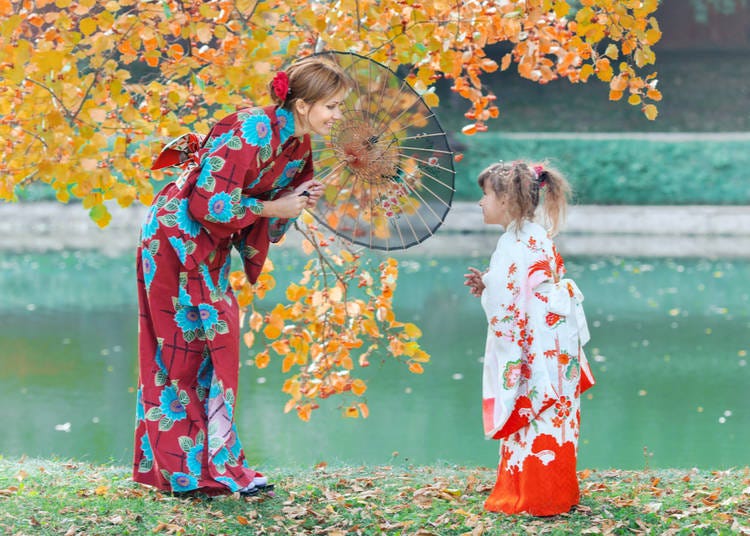
When choosing where you are going to visit it is best to be realistic about how you will get from A to B. Temples, shrines and castles will inevitably be located up steep hills, long stairs or on very rocky surfaces – more so outside Tokyo than in Tokyo.
For babies and small children it is best to always have a baby carrier handy, some places will have a dedicated storage area for strollers, some will not, so it is really a good idea to check what you are getting yourself into if there is somewhere you really want to go to.
Very old traditional places up in the mountains like Nikko might be challenging without a baby carrier, while walking around somewhere like Asakusa in Tokyo is absolutely fine with a stroller. In general, apart from some shrines and temples, most places are pretty accessible in Tokyo but can become increasingly more difficult the further into the countryside you go.
8. 3 Inside tips from an expat parent

a. Japan has a kid-friendly culture
A helpful tip to know about Japan is that having kids, even as a Japanese family, comes with a lot of benefits as culturally speaking there is a high regard for kids, especially young ones. So, don’t be surprised if men and women alike exclaim at your child’s cuteness or smile at their antics. In practical terms there is a lot of assistance, and consideration, for families with children which you can rely on during your trip.
For someone from a country like the UK where elevators in train stations are few and far between, you will be delighted with how there are elevators simply everywhere and you never have to worry about access into somewhere. There are also many free children play areas in shopping malls and department stores normally located where children’s toys and clothes are sold.
In general parents try not to inconvenience others by not using a stroller and using a baby carrier instead when going somewhere in Tokyo, and this has meant that some stores offer up a free rental stroller if you are in their store.
b. Cat/animal cafes are probably a no-go
While animal cafes, particularly cat cafes, are very popular tourist attractions they usually won’t allow anyone under 11 to enter, and to be fair this makes sense as you wouldn’t really want your baby or toddler to be playing with an animal! Luckily, as an alternative there are a lot of children’s cafes which you can use instead and which are far more baby-friendly!
c. Parks are difficult, but outside play areas are not!
A typical park in Japan, particularly small parks in urban areas, are to be avoided if you have a stroller, they are simply not designed with families in mind and can offer up a variety of obstacles ranging from muddy paths, loose rocks and countless steps with no ramp. However, there are plenty of outside play areas for kids which include dedicated areas for toddlers and larger kids, sometimes these can be found near a park but just as often they are not and can be found near schools.
Mahathir Mohd Yasin / Shutterstock.com
- Area
- Category
*Prices and options mentioned are subject to change.
*Unless stated otherwise, all prices include tax.
Recommended places for you
-

Discover Japan Duty Free GINZA: A Unique Shopping Experience in the Heart of Tokyo
by: Chehui Peh
-
Ad

Tokyo Comedy Bar: Where Jokes and Craft Beer Flow Freely
-

Hello Kitty theme park to be overrun by zombies this summer, young children barred from entering
-

New retro museum in Tokyo is like a time portal back to the Showa era【Photos】
-

Abandoned school being used for foreign tourists to experience Japanese high school in Chiba
-

Ramen vending machine brings a new noodle stand experience to Tokyo station
Inspiration for Accommodations
-

Enjoy Mt. Fuji from the Comfort of Your Room! Recommended Ryokan with Mt. Fuji View
-

Stay Near the Cherry Blossoms! Hotels for Cherry Blossom Viewing in Tokyo
-

Family-Friendly Hotels with Free Shuttle to Disneyland: Convenient Access for a Magical Stay
-

Top Ranked Hakone Hotels with Mt. Fuji View: Enjoy Stunning Scenery from Your Private Space
-

Convenient Tokyo Hotels with Airport Shuttle: Ideal for Families and Heavy Luggage
-

Stunning Tokyo Tower View Hotels: Enjoy Spectacular Scenery from Your Private Space
-

Convenient Asakusa Hotels with Kitchens: Ideal for Extended Family Visits
-

Experience Luxury: Hakone's 10 Best Five-Star Accommodations
-

Enjoy Mt. Fuji Autumn Leaves! Top Hotels Near the Popular Autumn Leaves Corridor
-

Experience Hakone Fall Foliage from Your Room with Stunning Views
-

Healthcare in Japan for Tourists: What to Do When You Get Sick or Injured in Japan
-

Ueno Station Area Guide: Fun Ways to Explore Tokyo's Popular Destination (Area Map & Sightseeing Tips)
-

Essential 25 Japanese Travel Phrases You Need to Know Before Your Trip
-

Secrets to Saving Money in 'Expensive' Japan: Tips From Real Travelers
by: Joe Turner
-

Secrets to Shopping in Japan: Guide to Annual Sales in Japan & Where to Shop
by: Miyu Shimada
-

Japan’s Unique Campus Festivals: Unwinding at Two Prestigious Universities in Tokyo!
- #best ramen tokyo
- #what to buy in ameyoko
- #what to bring to japan
- #new years in tokyo
- #best izakaya shinjuku
- #things to do tokyo
- #japanese nail trends
- #what to do in odaiba
- #onsen tattoo friendly tokyo
- #daiso
- #best sushi ginza
- #japanese convenience store snacks
- #best yakiniku shibuya
- #japanese fashion culture
- #best japanese soft drinks




















